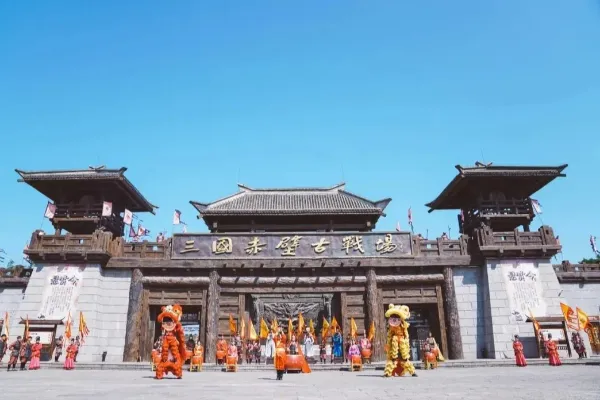
Located in Chibi City, Xianning, Hubei Province, the Three Kingdoms Chibi Ancient Battlefield is a national 5A-level tourist attraction covering approximately 4.7 square kilometers (core area 1.2 km²) on the south bank of the middle reaches of the Yangtze River. As the site of the historic Battle of Red Cliffs, it's renowned for its rich cultural relics and magnificent natural scenery, hailed as "China's No.1 Ancient Battlefield".
History and Culture
The Battle of Red Cliffs (208 AD) was a pivotal confrontation where the allied forces of Sun Quan and Liu Bei defeated Cao Cao, establishing the Three Kingdoms period. This battle represents one of China's most famous naval victories and classic examples of defeating a larger force.
The scenic area preserves numerous historical relics. The cliff inscriptions of "Red Cliffs" are believed to be written by Zhou Yu 1,800 years ago.
Literary giants like Li Bai, Du Fu and Su Shi visited here, creating celebrated poems. Su Shi's "Odes to Red Cliffs" particularly immortalized this site in Chinese cultural history.
Main Attractions
Red Cliffs Cliff Inscriptions
Two giant regular script characters "Red Cliffs" (each 150cm tall) carved on riverside cliffs, allegedly by Zhou Yu. Below stands the Ming-dynasty "Wind-Praying Platform" where Zhuge Liang supposedly summoned the east wind.
Zhou Yu Statue
An 8.58-meter stone statue of the Wu Kingdom general atop Chibi Mountain, depicting his heroic demeanor. The base features the complete "Nostalgia for Red Cliffs" poem, serving as the area's landmark.
Battle of Red Cliffs Exhibition Hall
This 3,200m² hall comprehensively presents the battle's background, process and impact through artifacts, dioramas and multimedia displays.
Young Phoenix Hermitage
Purported retreat of Pang Tong (nicknamed "Young Phoenix"), with current Qing-dynasty structures housing his statue and scholar inscriptions in serene surroundings.
Cuisine
Chibi Fish Cake
A centuries-old local delicacy made from fresh fish paste steamed with egg whites, known for its tender texture.
Dongpo Pork
Created by Su Shi in Huangzhou and later introduced here, this braised pork belly dish glistens red, melting in the mouth without greasiness.
Lotus Root Soup
Chibi's abundant lotus roots stewed with pork ribs create this milky, aromatic winter tonic soup.
Nearby Cuisine
Riverside restaurants serve Yangtze delicacies like steamed Wuchang fish and braised catfish, plus local snacks including bean skin sheets and rice wine.
Ticket Information
Ticket prices: 135 yuan (peak season Mar 1-Nov 30), 100 yuan (off-season Dec 1-Feb 28), covering the exhibition hall and hermitage. Half-price for students/seniors with ID.
Opening Hours
Open daily 8:00-17:30 (extended to 18:00 peak season). Exhibition hall 9:00-16:30, closed Mondays (except holidays).
Recommended Itinerary
Half-day tour: Morning at exhibition hall; Riverside sites including cliff inscriptions; Afternoon mountain visit to Zhou Yu statue and hermitage. Consider Yangtze cruise for majestic river views.
Transportation
- Self-drive: From Wuhan via G4 and G0422 expressways (~1.5 hours)
- High-speed rail: To Chibi North Station, then 30-minute shuttle
- Bus: Direct shuttles from Xianning (~1 hour)
Must-see Attractions
- Cliff Inscriptions: Millennia-old battle witness
- Zhou Yu Statue: Iconic general's imposing figure
- Exhibition Hall: Comprehensive historical insight
- Young Phoenix Hermitage: Three Kingdoms cultural immersion
Travel Tips
- Best seasons: Spring and autumn (Apr-May, Sep-Oct)
- Pre-reading about the battle enhances appreciation
- Wear comfortable shoes for mountain paths
- Try costume photography activities
- Evening riverside views are particularly photogenic
Precautions
- Exercise caution near riverbanks
- Protect cultural relics - no graffiti
- Spotty reception in some areas - stay with group
- Purchase souvenirs from authorized shops
- Wear life jackets during boat tours
- Summer sun protection/winter windproofing advised